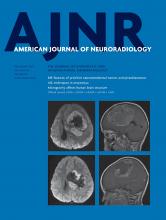Index by author
Inaji, M.
- Adult BrainOpen AccessBayesian Estimation of CBF Measured by DSC-MRI in Patients with Moyamoya Disease: Comparison with 15O-Gas PET and Singular Value DecompositionS. Hara, Y. Tanaka, S. Hayashi, M. Inaji, T. Maehara, M. Hori, S. Aoki, K. Ishii and T. NariaiAmerican Journal of Neuroradiology November 2019, 40 (11) 1894-1900; DOI: https://doi.org/10.3174/ajnr.A6248
Inglesby, D.C.
- EDITOR'S CHOICEAdult BrainOpen AccessProlonged Microgravity Affects Human Brain Structure and FunctionD.R. Roberts, D. Asemani, P.J. Nietert, M.A. Eckert, D.C. Inglesby, J.J. Bloomberg, M.S. George and T.R. BrownAmerican Journal of Neuroradiology November 2019, 40 (11) 1878-1885; DOI: https://doi.org/10.3174/ajnr.A6249
Brain MR imaging scans of National Aeronautics and Space Administration astronauts were retrospectively analyzed to quantify pre- to postflight changes in brain structure. Local structural changes were assessed using the Jacobian determinant. Structural changes were compared with clinical findings and cognitive and motor function. Long-duration spaceflights aboard the International Space Station, but not short-duration Space Shuttle flights, resulted in a significant increase in the percentage of total ventricular volume change (10.7% versus 0%). The percentage of total ventricular volume change was significantly associated with mission duration but negatively associated with age. Pre- to postflight structural changes of the left caudate correlated significantly with poor postural control, and the right primary motor area/midcingulate correlated significantly with a complex motor task completion time. These findings suggest that brain structural changes are associated with changes in cognitive and motor test scores and with the development of spaceflight-associated neuro-optic syndrome.
Isalberti, M.
- FELLOWS' JOURNAL CLUBSpine Imaging and Spine Image-Guided InterventionsYou have accessArmed Kyphoplasty: An Indirect Central Canal Decompression Technique in Burst FracturesA. Venier, L. Roccatagliata, M. Isalberti, P. Scarone, D.E. Kuhlen, M. Reinert, G. Bonaldi, J.A. Hirsch and A. CianfoniAmerican Journal of Neuroradiology November 2019, 40 (11) 1965-1972; DOI: https://doi.org/10.3174/ajnr.A6285
This study assesses the results of armed kyphoplasty using vertebral body stents or the SpineJack in traumatic, osteoporotic, and neoplastic burst fractures with respect to vertebral body height restoration and correction of posterior wall retropulsion. The authors performed a retrospective assessment of 53 burst fractures with posterior wall retropulsion and no neurologic deficit in 51 consecutive patients treated with armed kyphoplasty. Posterior wall retropulsion and vertebral body height were measured on pre- and postprocedural CT. Armed kyphoplasty was performed as a stand-alone treatment in 43 patients, combined with posterior instrumentation in 8 and laminectomy in 4. Pre-armed kyphoplasty and post-armed kyphoplasty mean posterior wall retropulsion was 5.8 and 4.5 mm, respectively, and mean vertebral body height was 10.8 and 16.7 mm, respectively. They conclude that in the treatment of burst fractures with posterior wall retropulsion and no neurologic deficit, armed kyphoplastyyields fracture reduction, internal fixation, and indirect central canal decompression.
Ishii, K.
- Adult BrainOpen AccessBayesian Estimation of CBF Measured by DSC-MRI in Patients with Moyamoya Disease: Comparison with 15O-Gas PET and Singular Value DecompositionS. Hara, Y. Tanaka, S. Hayashi, M. Inaji, T. Maehara, M. Hori, S. Aoki, K. Ishii and T. NariaiAmerican Journal of Neuroradiology November 2019, 40 (11) 1894-1900; DOI: https://doi.org/10.3174/ajnr.A6248








